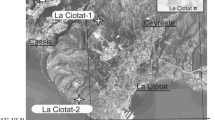Abstract
A feedforward neural network with one hidden layer and five neurons was trained to recognize the distance to kuroko mineral deposits. Average amounts per hole of pyrite, sericite, and gypsum plus anhydrite as measured by X-rays in 69 drillholes were used to train the net. Drillholes near and between the Fukazawa, Furutobe, and Shakanai mines were used. The training data were selected carefully to represent well-explored areas where some confidence of the distance to ore was assured. A logarithmic transform was applied to remove the skewness of distance and each variable was scaled and centered by subtracting the median and dividing by the interquartile range. The learning algorithm of annealing plus conjugate gradients was used to minimize the mean squared error of the scaled distance to ore. The trained network then was applied to all of the 152 drillholes that had measured gypsum, sericite, and pyrite. A contour plot of the neural net predicted distance to ore shows fairly wide areas of 1 km or less to ore; each of the known deposit groups is within the 1 km contour. The high and low distances on the margins of the contoured distance plot are in part the result of boundary effects of the contouring algorithm. For example, the short distances to ore predicted west of the Shakanai (Hanaoka) deposits are in basement. However, the short distances to ore predicted northeast of Furotobe, just off the figure, coincide with the location of the Nurukawa kuroko deposit and the Omaki deposit, south of the Shakanai-Hanaoka deposits, seems to be on an extension of short distance to ore contour, but is beyond the 3 km limit from drillholes. Also of interest are some areas only a few kilometers from the Fukazawa and Shakanai groups of deposits that are estimated to be many kilometers from ore, apparently reflecting the network's recognition of the extreme local variability of the geology near some deposits.
Similar content being viewed by others
References
Dowd, P. D., 1994, The use of neural networks for spatial simulation,in Dimitrakopoulos, R., ed., Geostatistics for the next century: Kluwer Academic Pub., Dordrecht, The Netherlands, p. 173–184.
Ishihara, S., ed., 1974, Geology of the kuroko deposits: Soc. Mining Geologists Japan, Spec. Issue 6, 437 p.
Kouda, R., and Singer, D. A., 1992, A resource assessment of kuroko deposits in the Akita region of Japan (abst.): 29th Intern. Geologic Congress, Abstracts, v. 1 (Kyoto, Japan), p. 83.
Kouda, R., and Singer, D. A., 1993, Evaluation of potentiality of kuroko deposits based on the probability distribution model: Geol. Survey Japan Bull. v. 44, no. 2/3/4, p. 91–103 (in Japanese with English abst.).
Masters, T., 1993, Practical neural network recipes in C + +: Academic Press, Inc., San Diego, California, 493 p.
Ministry of International Trade and Industry, 1983, Report of regional investigations for 1982 (FY): General investigation for statistical analysis: Ministry of International Trade and Industry and Agency of Resources and Energy (Tokyo), 621 p. (in Japanese).
Ohmoto, H., and Skinner, B. J., eds., 1983. The kuroko and related volcanogenic massive sulfide deposits: Econ. Geology, Monograph 5, 604 p.
Oshima, T., 1992, Geology, exploration and development of kuroko deposits (with emphasis on the Hokuroku District: Kuroko-type mineralization in Asia and the Pacific, v. 7, ESCAP, United Nations (New York), p. 10–27.
Poulton, M. M., Sternberg, B. K., and Glass, C. E., 1992, Neural network pattern recognition of subsurface EM images: Jour. Applied Geophysics, v. 29, no. 1, p. 21–36.
Singer, D. A., and Kouda, R., 1988, Integrating spatial and frequency information in the search for kuroko deposits of the Hokuroku District, Japan: Econ. Geology, v. 83, no. 1, p. 18–29.
Singer, D. A., and Kouda, R., 1992, Regional view in the search for kuroko deposits of the Hokuroku District, Japan,in Urabe, T. and Aoki, M., eds., 29th IGC field trip Guidebook, Vol. 6: Mineral deposits of Japan and the Philippines: The Soc. Resource Geology, p. 83–91.
Wu, X., and Zhou, Y., 1993, Reserve estimation using neural network techniques: Computers & Geosciences, v. 19, no. 4, p. 567–576.
Author information
Authors and Affiliations
Rights and permissions
About this article
Cite this article
Singer, D.A., Kouda, R. Application of a feedforward neural network in the search for Kuroko deposits in the Hokuroku district, Japan. Math Geol 28, 1017–1023 (1996). https://doi.org/10.1007/BF02068587
Received:
Accepted:
Issue Date:
DOI: https://doi.org/10.1007/BF02068587




